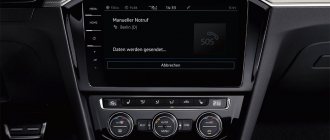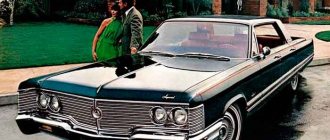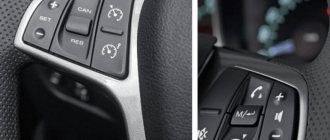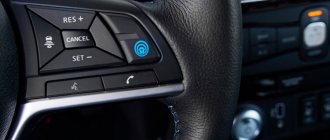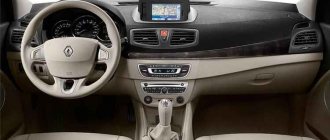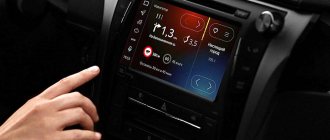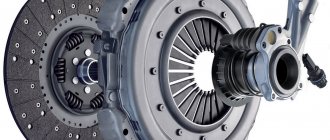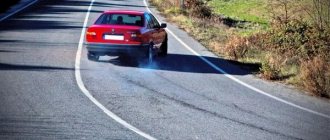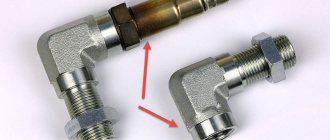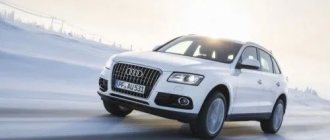Cruise control is not included as standard in many modern cars, despite the fact that this technological solution belongs to the list of useful car electronics. That is why car owners often decide to make changes to the equipment of their personal vehicles using a functional cruise control system.
The modern market offers a lot of ready-made kits equipped with an electronic unit, electrical wiring and controls. Below you will find out how convenient the systems are during operation, for which car models ready-made solutions are suitable, and how to connect the system in a garage yourself, without the involvement of specialists.
Operating principle of passive cruise control
The simplest system for maintaining cruising speed includes the following main elements:
- vacuum or electric drive for turning the throttle valve with a cable;
- electronic control unit;
- set of sensors;
- control buttons located on the steering column switch or directly on the steering wheel.
Note. The number and type of sensors depends on the specific brand of car. Typically the kit includes a speed meter and limit switches for the brake and clutch pedals.
The controller, operating independently of the main engine control unit, is installed under the dashboard. The drive connected to the ECU is located next to the throttle valve and is connected to it by a cable. Cruise control on “mechanics” works according to the following algorithm:
- The driver accelerates the car to cruising speed, turns on the automatic and releases the accelerator pedal.
- The controller remembers the speed value and sends a command to the drive, which opens the throttle to the required angle.
- When driving uphill, the sensor records the deceleration of the car and transmits information to the control unit. The ECU forces the drive to open the throttle more, the fuel supply increases and the car maintains its original speed.
- On a descent, the picture is the opposite - the throttle closes as the car accelerates downhill.
- If the driver accelerates or decelerates the vehicle using the buttons, the damper is rotated by the drive through a small angle.
On a manual transmission, the effect of cruise control is limited to the speed range of one gear. If for some reason (for example, a steep hill) the car slows down to 30–40 km/h, the system is automatically deactivated. The electronics operate in a similar way when pressing the clutch and changing gears, so the driver has to constantly resume its operation.
With an automatic transmission, using cruise control is much more convenient. Since the automatic transmission changes gears depending on the oil pressure in the torque converter, that is, on engine speed, switching occurs automatically during acceleration or deceleration of the car. Robotic boxes equipped with an electric drive receive a request to engage the next gear from the controller.
On vehicles equipped with an electronic gas pedal, the throttle is initially controlled by a vacuum or electric drive. After activating the mode, the ECU takes over control of the drive mechanism and maintains the course speed.
Is it possible to do a cruise on your own?
When making a CC yourself, the following questions arise:
- where to get a diagram that does not need to be altered to fit your car;
- how to ensure overall system reliability;
- how to avoid mistakes that can lead to tragedy.
where to get a servo drive with suitable characteristics;
A large number of different diagrams taken from production cars of the end of the last century are posted on the Internet. Finding parts for them is problematic because they are no longer produced. If you use modern circuits with microcontrollers, then no one knows how such a circuit will behave during some kind of failure. Perhaps it will lower the engine speed to idle, or maybe it will sharply increase it to maximum. If this happens at a sharp turn, tragedy cannot be avoided. Another problem is the servo drive, the pitch of which is tenths of a millimeter. This will allow you to smoothly regulate the speed of the car and avoid jerking.
Many DIYers suggest using a motor and gearbox from windshield wipers for this, however, this option is not very good due to high inertia and difficulties with adjustment. If you use the electronic gas pedal drive from a damaged foreign car, then why not take the control unit from there? Installing such a drive on a car with a throttle cable will require installing and connecting a servo drive to the throttle valve. All this allows us to conclude that you can do cruise control yourself if you are well versed in electronics, have access to the component base and can carry out a serious modification of the car yourself.
Will cruise control work fully on a manual transmission?
The operation of cruise control on a manual transmission is practically no different from its operation when installed on a car with an automatic transmission.
However, in this case, there may also be one drawback: when trying to go uphill with cruise control turned on, the driver will not be able to automatically switch to a lower gear.
Because of this, if the driver is driving in 5th gear of a manual transmission, then without additional pressing of the gas pedal he is unlikely to be able to completely overcome the entire climb.
In such a situation, another feature of cruise control appears - if the car’s speed decreases (which happens when it is impossible to drive onto a slope), the device automatically turns off at 40 km/h,
so the driver will in any case have to resort to mechanical control of the gas pedal.
IT IS IMPORTANT!
RES button on the cruise control device , you can reset the speed by pressing it twice. If it is absent, you can reduce the speed by pressing the gas pedal and fixing the new speed using the cruise control start button.
Advantages and disadvantages of the system
The advantages of this device are obvious - reducing the load on the driver. This is especially important during long trips along the highway, lasting more than one hour. The driver's leg does not get tired, because the control unit automatically increases or decreases the fuel supply, so the speed does not change. However, this device is not without its drawbacks. Any malfunction in its operation can lead to an accident, because it independently regulates the fuel supply to the engine. Another drawback is that this device relaxes the driver, which causes his concentration to decrease. This can also lead to an accident.
Adaptive Cruise Control System
With the first manifestations of interest in such a product, the creators of such systems began to actively promote and modernize the existing product. New generations have improved the system's response to driver reactions, and the stability of cruise control has increased. However, the real breakthrough was the invention of the adaptive type of cruise control (“ACC” - Adaptive Cruise Control).
We recommend: Gasoline or diesel. What's better?
While a similar type of system, adaptive cruise control has a number of advantages that allow you to take your ride comfort to an entirely new level. The system design includes a radar installation (in some versions there are several of them), which takes into account the distance to the nearest object in front and controls the speed limit depending on the situation. In other words, adaptive cruise control allows you to maintain a safe distance from the car in front, adapting to changes in its speed.
The beacon located in the radiator part actively interacts not only with the digital processor, but also with the braking system. After the obstacle ahead disappears, the vehicle automatically returns to its original speed.
How adaptive cruise control works.
↑ In euphoria, I created the first version of the scheme:
Fragment excluded. The full version is available to patrons and full members of the community.
The output is produced through a hardware PWM controller. Everything was great in Proteus; small voltage fluctuations (about 0.01 volts) did not bother me. It's time to hit the iron! I had to be distracted first by mastering the LUT technology, then by making a normal programmer based on PROTTOSSa. But even here the time is not wasted, now I can handle the production of small printed circuit boards of sufficiently high quality! At the same time, I mastered coating with Rose alloy, and I also really liked the results.
Fragment excluded. The full version is available to patrons and full members of the community.
"Mechanics" and cruise
Most often, cars with automatic transmissions are equipped with this function, although you can independently install cruise control on a manual transmission if this option is not provided by the automaker. In this case, you will have to change gears yourself.
A specialized company will also help you with tuning to install the cruise. Some organizations have universal systems prepared for installation. It is also possible to independently purchase electrical equipment. In this case, the car owner selects the most comfortable option for his vehicle, taking into account ergonomic features.
Let's explain how cruise control works on a manual, because there is some difference here from working on an automatic. When you press the clutch or brake pedal, it switches off automatically. The driver must shift the transmission to the desired gear and then reactivate the cruise control if necessary. Also, the shutdown is performed when the ignition is turned off, as is the speed settings reset.
Install and connect the steering column switch
Required
- steering column switch (article 1119-3709340-20)
- Steering column switch connector (part number AMP 174922-1)
- terminals to the dashboard connector (part number AMP 963715-1)
Installation
:
- Remove the steering column cover (unscrew the fastening screws from the bottom and side).
- Squeeze the clamp and remove the standard steering column switch.
- Install a new steering column switch with buttons. Connection
- Remove the instrument panel
- Connect the new steering column switch to the dashboard (green -> 23 panel pin, red -> 24, yellow -> 10, black -> “ground”)
On Standard configuration
: Do the first start of the dashboard with a test (press the daily mileage reset button and turn on the ignition), the cruise control and speed limiter indicators should light up.
Mechanics and cruise control
Not everyone has the opportunity to buy a car like the latest generation Toyota Camry, where adaptive cruise control is installed along with an automatic transmission. Someone also got an ordinary Vesta on their handle. But I still really want to equip the car with the function of maintaining a speed preset by the driver.
Why do you need a car tachometer: what types are there?
Category: Auto gadgets
It is wrong to think that connecting to cars with cruise mechanics is something fantastic and impossible. If you figure it out and try hard, the function will appear on almost any car. Only you must first decide whether you need such a system, or no one will actually use it. Don't rush to spend money on something you won't need. Although the final decision is yours to make in any case. Your car, your rules.
Some systems, such as GLONASS, are already provided on many cars as standard factory equipment. But rear view cameras or the same car navigators often have to be purchased and installed separately. The question of their necessity in a car is as relevant as in the case of cruise control.
I don’t argue that the connection diagram for the CC on cars with automatic transmission is much simpler. Car manufacturers have provided for the possibility of installing the system from the factory. Therefore, to connect, it is enough to buy equipment and install it in accordance with standard locations.
But when we talk about manual transmission, things are somewhat more complicated here. If the CC is not provided by the factory, you can still install the device. To do this, install universal equipment with your own hands or the hands of craftsmen. Experienced car owners advise giving preference to German systems. Their price is higher, but you get a unit of increased reliability. The overpayment is worth it. Just when purchasing, carefully check all components and the ability to return the product if it does not fit.
Technically, you have to install an additional bracket and a special cable attached to the gas pedal, which makes it possible to maintain the speed at the specified values. Plus, buttons are mounted on the bottom of the deflector for control. But it will turn off whenever you press the gas pedal. Therefore, you will have to press the button again to activate the cruise.
Probability of full-time work
In functional terms, the CC installed on a car will differ little from a similar system on cars with automatic transmission. Therefore, it is not difficult to figure out how to enable or use the innovation.
Recommended: Methods for monitoring battery status
The only question is why you need a cruise. Some only realize over time that it was a mistake to install such a system on the car. If you regularly drive on highways and highways where you can maintain one speed for a long time, then an additional lever responsible for cruise control will definitely not hurt. But when driving around the city in heavy traffic and constant stops, the cruise loses its relevance and becomes a completely unnecessary element.
This is the case with engine pre-heaters. Drivers understand that they do not need them at all, since such systems are relevant only for the most severe climatic regions with cold winters. Although I have nothing against the same fog lights. A really useful assistant in case of poor visibility on the road.
If you need QC, it can be supplied quite quickly. In this case, management will not cause any difficulties. Check with the car service center to see if cruise can be installed specifically in your case. But practice shows that this is possible on almost any car.
But also keep in mind that there are some nuances here. Namely:
- Departures on the rise. With such an uphill movement, the car will not switch to a lower gear on its own with manual transmission. This will have to be done manually;
- To drive up a hill in 5th gear, you need to press the gas pedal yourself. Otherwise, you won’t get out on the climb;
- With a gradual decrease in the current speed of the vehicle (on the same rise), the CC will automatically “turn off” at around 40 kilometers per hour;
- If there is a RES button, the driver can reduce the speed by pressing it 2 times. If it is not there, you will need to press the gas pedal and determine the new required speed for the CC with the start button.
As you can see, there are some nuances here. But they are not critical.
That’s why you can increasingly find video instructions online where garage technicians talk about the features of self-installation of additional equipment. In the case of cruise control, I would advise contacting trusted specialists and certified workshops.
↑ Outputs:
1. Hammer and drive like this. Not interesting, it’s more convenient with a cruise. 2. Buy a car with cruise. Expensive and I like this one. 3. Find a used ECU with cruise firmware. Unreal. Who can tell you whether there is anything inside or not? And it costs 2 green pieces. 4. Remodel the existing side panel using “smart” ones from the garage. In an unfortunate case, we have a faulty ECU and a dead car. 5. Buy a German universal one //www.waeco.com/en/4374.php, it fits many cars. Mitza is not on the list. Collective farm again? Give 15 grand and start a collective farm? 6. Assemble it yourself. Inexpensive, learn how to handle microcontrollers, exercise your brain. And how many other Japanese Grandees are driving around the country... Plus Airtracks, plus right-hand drive Outlanders, and the same Galantes. There are also a lot of them; the experience of cruise construction is clearly not the only one that will be useful.
How the adaptive version works
Advanced electronic systems are installed on cars equipped with an automatic transmission or CVT. In addition to the elements listed above, adaptive cruise control involves an ultrasonic radar, a brake drive and several additional sensors mounted in the car’s body parts.
How active cruise control works:
- At a certain speed exceeding 40–50 km/h (the exact value depends on the make and model of the car), the driver activates the automation and releases the gas pedal. You need to perform an additional action - set the distance to the obstacle or the car moving in front using a separate key. The number is reflected on the display of the on-board computer.
- When the radar detects an approach to a vehicle, the ECU closes the throttle and slows down, and then adjusts to the speed of the object, maintaining the set distance.
- If the front car brakes, the electronics will stop the car. To move away, the driver needs to press the accelerator or press the appropriate key.
- If the vehicle ahead veers off the road, cruise control will accelerate your car to the initially set speed.
The system will respond to a stationary obstacle by braking until it comes to a complete stop. You must understand that simply turning on the cruise is not enough control; you need to monitor the road situation yourself . The radar coverage range is 150–200 m and at high speed this distance may not be enough for braking. When approaching a static obstacle, the driver must take control.
In business class cars and above, adaptive cruise control is often combined with other useful systems - recognition of road markings and signs, collision avoidance and automatic high beam control.
The process of connecting cruise control to a manual transmission when it is not provided by the manufacturer
Before proceeding with the installation of cruise control, the car owner must make sure that all technical components of his “iron horse” are in working order, and also install good tires on the car. This is due to the fact that in the presence of such malfunctions it is very dangerous to allow the car to drive under automatic control. If everything is in order, the driver will not endanger himself by driving on cruise control.
We recommend: Contact ignition system - what is it and what secrets does it keep?
What you will need for installation
To complete the work, it is important to prepare in advance:
- curved screwdriver;
- scissors or an awl (the main thing is that they are very sharp);
- knife;
- nut head;
- wrench;
- a set of self-tapping screws (screws can also be used);
- a cable for connecting to the accelerator (it can also be included with the device);
- universal cruise control.
IMPORTANT! If your car has an accelerator pedal position sensor, then you will need to purchase an additional bracket for it, which you will also have to install yourself.
Installation process
In general, the entire work of installing cruise control on the mechanics will take you no more than an hour, however, you should set aside time to check the operation, as well as eliminate possible malfunctions. In general, the work consists of the following sequential actions:
- Choosing a location for the new device. Often, car enthusiasts attach it near the fuel filter, which also allows you to connect the cruise control to the brake hose. You can choose another place for it, the main thing is that it is dry, and the cable from the accelerator can be freely connected to it (if there are strong bends in the cable, you will not be able to control the speed).
- We connect the second cable to the accelerator, but do not rush to cut it. First, install the bracket on the gas pedal position control sensor, and only then measure the required length of the cable and cut it. After this, the second end of the cable can be connected to the cruise control device.
- To connect cruise control to a car, you must first find the tachometer connection wires, to which you need to connect the new device. The green wire that comes from the cruise control control unit must be connected to the tachometer wire. The red wire of the device is intended for connection to brake lights.
- Install the cruise control activation/deactivation button. To connect it, we connect the gray double wire. For full operation of the button and device, be sure to stretch the ground that runs along the black wire.
- The cruise control control knob must be installed on the steering wheel of the car, for which it will have to be disassembled. If your car has airbags, they will also have to be removed for a while. We install the handle on the steering wheel and put it back together, not forgetting about the airbags.
IMPORTANT! If you cannot run the cable from the accelerator in such a way that there are no bends in it, you can use a regular fishing reel, along which it will bend freely without breaking or damaging other mechanisms of the car.
We check the operation of the cruise control. To do this, we recommend that you drive along an empty road where there is no traffic. It is rational to do a test activation of the device at low speed (but above 40 km/h), while being prepared for the need to control the accelerator pedal if the device suddenly does not work.
To bet or not
It is not possible to answer this question unambiguously. If you are a connoisseur of automotive electronics and all kinds of gadgets, then cruise control in combination with a jetter will outweigh the high cost of the system and the likely difficulties of the upcoming work. The downside can confidently be considered interference with the operation of the on-board electronics installed by the manufacturer. If you decide to install cruise control yourself, the Jet-cruise KH diagram will be much simpler and clearer. Such equipment is installed much faster, plus the convenience of control using the remote control.
Installing cruise control on your own is quite a painstaking and responsible task. In order to minimize risks when installing a cruise system, you can contact our professionals by filling out the form below.
What is cruise control
Cruise control (Passive Cruise Control "PCC") is a system that allows you to maintain a set speed automatically, without driver intervention in the process. This control principle implies facilitating the driver's participation in the partial loss of control over driving. On long trips, this function allows you to distract yourself from the driving process, up to a certain point.
To understand the principle of operation of cruise control in general, you need to understand how cruise on an automatic transmission (automatic transmission) works. There are several options for control systems for this function. For example, some cars are equipped with a special button located on the steering wheel, after activation of which the car accelerates by exactly 1 km/h. Depending on the presses, the speed level will also change (20 presses will speed up the car by 20 kilometers per hour). To stop PCC, you must press the gas or brake pedal.
Control knob for the cruise control system in a car.
With cruise control, it is easier for the driver to control the car, both with an automatic transmission and a manual one. You can install this system yourself if you have an electronic control unit. Modern cruise control improves safety on the road.
What is it and what is it used for?
Before installing an unfamiliar system in a car, it is better to learn as much as possible about its operation. So, cruise control - what is it? This is a system for automatically maintaining a certain speed limit without driver participation, regardless of external factors - load on the car, wind direction and speed, ascents and descents, etc.
In the old days, when there was no talk of the existence of compact computers, rare craftsmen managed to achieve what they wanted - to fix the throttle valve in a certain position. But maintaining a constant speed in such a way on a flat road was considered extremely difficult. As computer technology improved, constant speed mode became more convenient. All that is necessary for the effective operation of a ready-made cruise control kit is to establish interaction between the system and the vehicle’s power unit.
Manufacturers of automotive electronics produce kits that are completely ready to ensure that installing cruise control with your own hands does not become a problematic task. In order to simplify the connection of the system to on-board network components, the kits are adapted for a group of vehicles. That is, the equipment cannot be called universal. Grant, Duster, Solaris and other cars equipped with an electronic accelerator are suitable for Jet-cruise KH and Drivenge.
Both devices are manufactured by Russian companies; their stated capabilities have common characteristics and capabilities. Both systems are suitable for installation in a car with a manual or automatic gearbox. However, one difference is noted: in a car with a manual transmission, after each speed change the set value is reset, so a new switch is necessary. It is worth paying attention to similar options - a jetter for the Jet-cruise KH and a booster pedal for the Drivenge.
